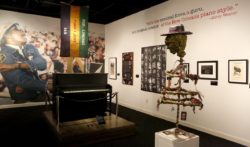Louisiana State Museum
He Showed Us What Carnival’s For
A new exhibition at the New Orleans Jazz Museum celebrates Professor Longhair’s Centennial
Published: December 3, 2018
Last Updated: March 1, 2019

Photo by Baylee Badawy / New Orleans Jazz Museum
Me Got Fiyo at the New Orleans Jazz Museum.
Born in Bogalusa on December 19, 1918, Byrd’s mother moved him to New Orleans within a year. As a kid, Henry and his friends salvaged discarded pianos that music stores left on the sidewalk, dragging them home to experiment with different types of music, which many musicologists think gave birth to his unique style.
Before he started playing professionally, Byrd worked in a Civilian Conservation Corps camp in the late 1930s, where he entertained fellow workers and soldiers. There, he remembered performing with musicians from Spain, Jamaica, Hungary, and other far-flung spots, to whom he attributed his syncopated rhythms and riffing. Soon after, he took a piano job in downtown New Orleans. Nobody knew his name, so patrons of the club called him “Longhair,” referring to his long-for-the-era hair.
In the 1950s, Professor Longhair recorded some of the great classics of American music: “Bald Head,” “Tipitina,” “In the Night,” “Mardi Gras In New Orleans,” and many others. As the 1950s wore on, Fess, still in demand as a live act, didn’t sell many recordings. Even classics, such as a rerecording of “Mardi Gras in New Orleans” in 1959 and “Big Chief” in 1963, didn’t help his popularity and finances. Finally, Fess stopped playing music and virtually disappeared.
Fess spent this time in his Central City neighborhood, gambling and running card games. He might have continued down this path, but several music fans tracked him down. Hudson Marquez found him in a corner bar running a cooncan game, an early form of rummy. Quint Davis and Allison Miner had been working on the New Orleans Jazz and Heritage Festival, and they got Fess to headline it. This performance jump-started Longhair’s career. A group of fans started a club for him and named it Tipitina’s, after one of his most famous songs. By the end of the 1970s, Longhair had recorded the album of which he was proudest, Crawfish Fiesta. Stevenson Palfi began work on his documentary Piano Players Rarely Ever Play Together, which traced the piano influences of Tuts Washington, Professor Longhair, and Allen Toussaint, and which was to feature a concert where all three musicians shared the stage. Alas, on January 30, 1980, just days before the concert, Henry Roeland Byrd passed away in his sleep.
Professor Longhair’s influence has only grown since his death. His music captures the cultivated eccentricities of New Orleanians, down to the way they walk, saunter, slide, and, most of all, dance. Whatever the DNA of the Crescent City looks like, Henry Roeland Byrd’s piano is a strand of it.
Visit the exhibition Me Got Fiyo: The Professor Longhair Centennial through July 2019 at the New Orleans Jazz Museum at the Old U.S. Mint, 400 Esplanade Avenue, New Orleans.

